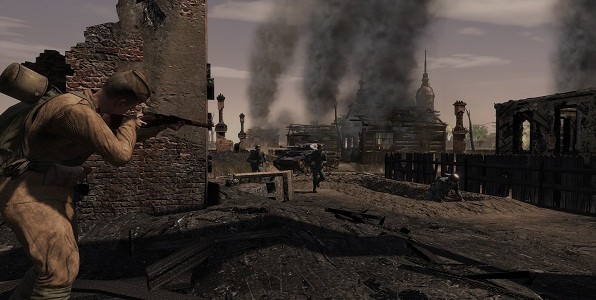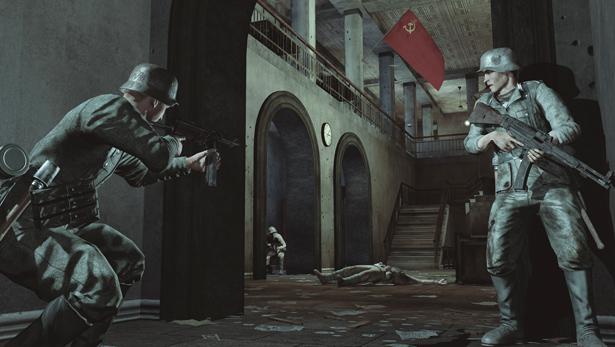My team has been trying to capture a crucial church from Russian forces. The Russian team is heavily fortified, with machine gunner crews in the windows, snipers in the tower, and riflemen dotting the landscape as we try to make our advance. Our squad leader finally reaches the line, pops a smoke grenade, and our team makes an advance under its cover. As I sprint to the far end of the building, I spot three enemies behind cover that haven’t noticed me. I find sandbags and find cover behind them, pulling out my rifle. I take careful aim at one of the enemies, steady my breath to increase accuracy, and squeeze the trigger. The player goes down, a 73 meter kill. The shot alarms the rest of the opposing team and a sniper fires. The bullet connects and I fall to the ground, the screen slowly fading to black as I bleed out, watching my fellow teammates continue a slow assault on the church. This is Red Orchestra 2: Heroes of Stalingrad.
The above story exemplifies both the mood and gameplay of RO2, the sequel to Red Orchestra: Ostfront 41-45. For those unfamiliar with Red Orchestra, the series is an ultra-realistic World War 2 shooter that seeks to mimic every aspect of warfare from the time period. Players deal with little to no UI, account for bullet drop and spin, and inhabit an environment where one bullet can bring you down. It’s a hardcore shooter that may seem impenetrable at first, but like all great PC games, will reveal itself to players the more time you give it and actively try to learn its systems.

The main difference between the original RO and its sequel is a more robust single player campaign mode instead of the bot match practice mode of the original. The campaign places players on either the Russian or German army during the Battle of Stalingrad. Each mission is prefaced by a cutscene explaining the situation from both point of view and each chapter is closed with passages from soldiers’ journals or quotes heard from them. These cutscenes do such a fantastic job setting the mood for one of the bloodiest conflicts during the war that it’s a genuine shame that the campaign couldn’t follow suit. The majority of the missions are just bot matches strung together by the cutscenes, where you’ll be playing on maps that follow the same scenario as territory game types. Every few missions, there are some interesting twists where you have to defend instead of attack or pilot tanks, but there’s no real campaign here.
Add the fact that the A.I. is truly terrible and the campaign is beyond useless besides teaching you game mechanics in a controlled environment before jumping into the real chaos of multiplayer. Giving orders to squad mates is a joke, as the bots will either not follow them, or rush blindly into enemy fire without taking cover or finding another way. When they do take up positions, bots will stand up during firefights or take cover on the wrong side of obstacles, again in enemy fire. It makes tactical options in a tactical shooter worthless.
Campaign isn’t the focus of RO2, though; it never was. There is no epic storyline to follow. Instead, RO2 nails every aspect of multiplayer so perfectly that single player should have just been left on the cutting room floor – it wouldn’t be missed. Developer Tripwire Interactive has made great strides in the multiplayer space offering both familiar and new gameplay modes, along with innovative team mechanics. Firefight is a standard Deathmatch mode, while Territories has both teams fighting over fixed control points. Finally, Countdown provides each player with one life and only grants a respawn if the attacking team can capture the objective pushing the battle forward.
Players can inhabit multiple roles, including riflemen, machine gunners, engineers, anti-tank, and snipers. The game limits how many players can inhabit each class, so there can’t be too many players playing one class, creating unbalanced teams. This is a crucial choice because in a realistic shooter like this, players will need a complete team to succeed. Squad Leaders have the ability to be roaming spawn points, pop smoke grenades to make advances and give orders that players can choose to follow (more on that later). They can also spot targets with their binoculars, which the Commander class can then use to order artillery strikes on those targets. This cohesiveness is what RO2 gets completely right: feeling like part of a well-oiled machine once everyone plays their part.
In order to ensure people are playing their part, RO2 uses an honor system to reward players. As you capture control points or accept orders from your squad leader, you gain Honor Points. Doing “dishonorable” actions subtracts points: camping away from objectives, spawn camping, or team killing. Players will want these points as they level up overall ranks and classes. As players level up classes, more weapons and equipment will be unlocked for that class, so it behooves one to be a team player.

The feel of RO2 is one of the best in the FPS genre I’ve had the pleasure of playing. The realism enriches every aspect of the shooter and makes mundane and common things in other games more satisfying here. Where kill streaks are now common, getting even 5 kills in a row is an accomplishment. Capturing an enemy base and pushing them back even further is a more amazing feeling because players have to earn it using team strategy and all the tools available to them. Pulling off a long distance shot with a sniper rifle provides a rush that won’t be felt in other games, accounting for so many factors instead of just point and click. Instead of jumping into a tank and rolling around in kills, tanks require up 5 players to operate properly. Once you have the experience of lining up the shot with the help of another player spotting and then getting that kill, you’ll have a hard time going back to simpler games. It’s a pure experience in a genre that has now become mired in flashing numbers and instant gratification.
Visually, the Unreal Engine 3 pulls its weight, rendering the bombed out buildings and war torn streets of Russia during the time period well. The slow texture pop-in that is standard on this engine is present here, mostly during intense respawns in the middle of combat. It never gets in the way though, taking too long to fill in the textures as in other games, so it seems Tripwire has found a way to reign this engine in. The music doesn’t match the same visual beat, though, with the soundtrack mostly composed of generic tracks that have been heard in any World War 2 game in the last 10 years. It’s not offensive in anyway, but there are no standouts or sweeping scores.
Forget about Red Orchestra 2‘s single-player campaign. Its main function is to teach players the game with terrible A.I. bots to keep the company. Where this game shines, and shines brightly, is in multiplayer. It’s a well-crafted game that will feel off-putting and foreign at first. But once players give it the time it needs, dive into its systems, and learn them, they will find a game that fills a void that the current trajectory of the FPS genre has left vacant.

















